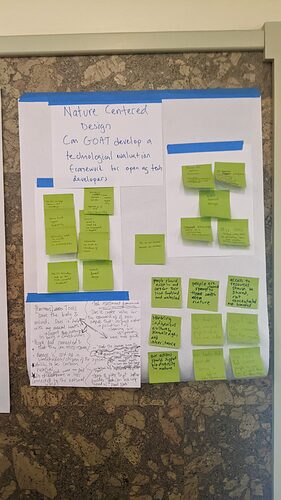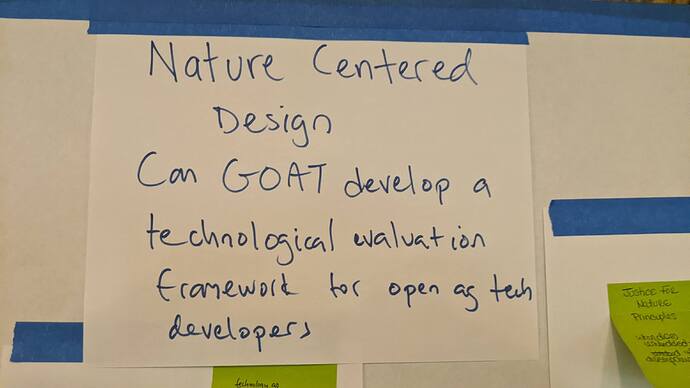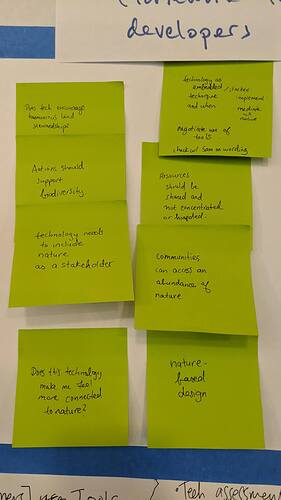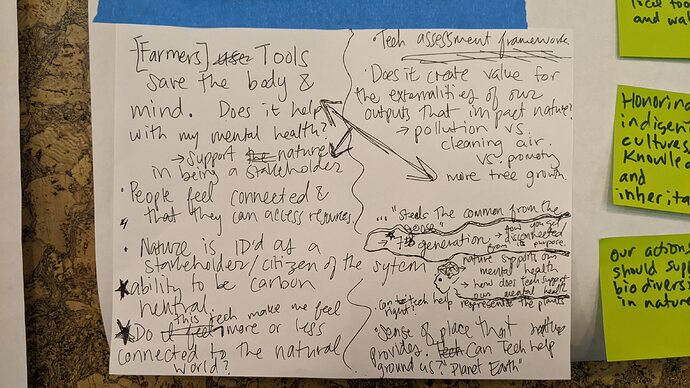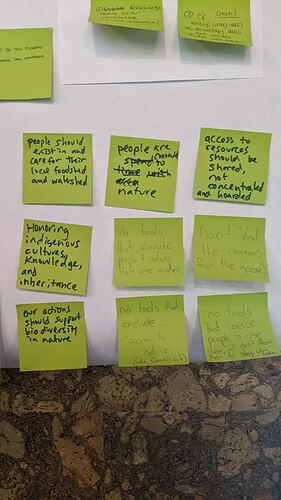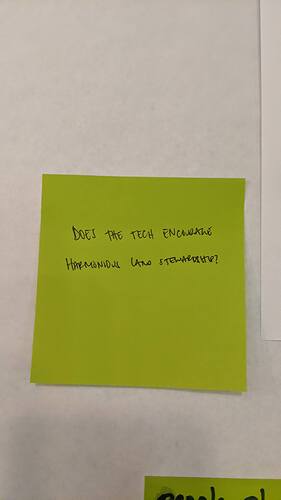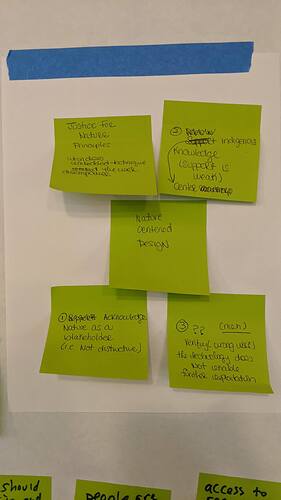Session: Justice for Nature
- Facilitator: @ljodom
- Documenter: @samuejao
- Transcriber: @jgaehring
Finally getting this posted! I’ll make it a “wiki” so others can make fixes and amendments if necessary.
General Discussion
-
Learning to give back to nature that nourishes
- Thinking and creating not in a nature tech binary
- Tech sovereignty through agroecology
-
Nature not as a resource but a partner in this journey
- Nature is not there to serve us - we are there to care for and steward and partner
- How does justice for nature show up in the work you do?
-
Climate grief
- we are operating with an injury that comes up with the current crisis
- We are seeking unification and spiritual and other connections with nature
- Emotional gap that influences how we approach our work
-
Is technology aligned with nature?
- How to not move toward solutionism but opening spaces to understand how we relate to the concept of justice of nature and other aspects of justice.
-
Looking at supporting nature and sustainability through technology
- how to improve the world through tech or how to improve tech in the environment
- Nature is one of the stakeholders for which we develop tools
-
Countries that are giving nature rights
- indigenous communities that recognize rights to communities.
- Regenerative ag and how it is aligned with indigenous practices
- It doesn’t always have to be high tech
-
What is technology and how can it support nature as a stakeholder?
- it is fine to be broad in a definition
- point of language is to make distinction and points of understanding.
- But when we generalize it can make it hard to speak about specifics.
-
Technology is a lever
- lever of power that is embodied in an artifact.
- It is scalable.
- It is a thing that you can walk away from.
- Difference between high and low tech is the scale of the lever and what it can do?
-
What responsibility do we have for the technology we create?
- What are downstream impacts of our technology?
- All solutions have to consider the contexts in which they are applied…
- exploring hydrogen, for example, intent is innocent but the use is inherently.
-
Intent
-
if you set out with the intent to create a WMD, but the line between the two is pretty.
-
The shovel or the weapon can be used for many things.
-
Questions:
- What are we creating?
- Is it helpful?
- Is it what communities need?
- Do we impose our beliefs and words on people?
-
-
The statement, “Technology is neutral”, what does that mean?
- But sometimes we mean science.
- Technology is not just science.
- Technology is how we take science and implement it.
- How we change it, modifying it into something else.
-
Design intent
- Design is part of our nature and is value laden.
- When we try to harness the power of nature, that intent can be destructive.
- How much of our world-building is about subjugating nature?
-
Technique
- Stacked techniques are embodied intent.
- Physical things provide an easier way to understand things.
-
Hardware vs. Software: how to tease apart the difference between software and hardware?
- Hardware allows us to manipulate the earth
- software allows us to work in a fluid reconfigurable ideas
-
How we can use things with different intent.
- Ad Hoc work arounds…
- In open source the intent is to create things which can be built upon by others.
- The intent is so buried deep in the “stack”.
-
Can we differentiate between technologies and the values of agriculture work?
- So what does it take to build technologies that support environmental and social well being?
-
Other ways to mitigate the use of our tools and the impact on nature
- Are problems we create through tech tractable?
- Are we only responsible for the intent of our tools?
- Are there external bodies that need to be at play at well
- Ultimately we are going to be building something and other
-
Amish example of technological assessment
- can we develop an assessment framework for technology?
- Actuarial intelligence
- How we can develop in to the community ways of balancing unequal distribution of power
- Amish society has prioritized these values
- So we have to come up with an agreed upon social contract.
- Perhaps we have become so spread out that we lose a level of connection to community and it is harder to develop shared community values.
- Amish have all bought into shared values.
-
Would we ever see a world in which we have societal agreements around nature and the environment?
- Eg, B-corps
- We have all kinds of standards in place for other kinds of things (this is good, that is bad)
- But we don’t have anything like this for nature.
- So different groups
-
Could GOAT actually make it part of its mission to support and have justice for nature?
- As we create a manifesto, could we embed justice for nature and all in the foundation?
-
Amazing technologies that can be used to connect
- David Attenborough’s Planet Earth videos that provide calm
-
Are there any examples where the connection to nature is embedded that could be positive examples for GOAT?
- La Via Campesina
- have created a global community of regional networks that have a clear justice framework
- When we think of scalability and having intentions for tech not to cause harm how can we communicate where we are as a structure?
- What does GOAT want to be as an organization
- It would be interesting to see what criteria we have (ie 3 ideas)
- What would be three principles or criteria ?
- How to gauge and assess the ways in which technology supports
- They are establishing things that we want! What are priorities
- See Justince for Nature Principles below
- La Via Campesina
QUESTION and RESPONSES
Could GOAT develop a technological assessment framework to help developers consider the impacts of their technologies on nature?
- Being able to have access to the abundance of nature
- Don’t do things that disallow us from doing that
- Does the technology or tool acknowledge nature as a stakeholder
- Acknowledging or centering indigenous knowledge if appropriate
- Does the technology you developing move towards exploitation
- you could develop licenses that support this?
- Does the tech encourage harmonious land stewardship
- Our actions should support biodiversity in nature
- People should exist in and care for the local food shed
- Access to resources should be shared, not concentrated and hoarded
- Tools that support conviviality…
- Access to nature
- Does this tool move us toward enclosure?
- 17th Century folk poem about enclosure:
The law the locks up the man or woman
Who steals the goose of the common,
But leaves the greater villain loose
Who steals the common from the goose.
- 17th Century folk poem about enclosure:
- How do the tools we use mediate and disengage from out environments?
- eg) zoom - what are the knock on effects of a technology
- THere are some things that are clear that we don’t want -
- but more abstract things even have direct impact
- and more than that are the unintended and unperceived things (algorithmic basis)
- How to create a framework to remind us
- Some kind of intentlike analysis? Like lifecycle
Could these ideas feed into a technological assessment or technological evaluation framework developed by GOAT which could be available for developers?
It could function like a matrix where technologists could run ideas through and ask questions about whether the technology adheres to different aspects of the assessment. It could be a prompt for developing with nature and society in mind.
Nature Centered Design?
Because human centered design is too anthropocentric
Justice for Nature Principles
Based on the discussions above, we decided to each take some time to write down some principles we thought could guide an evaluation or assessment framework for GOAT to decide what technologies are appropriate for our community.
“Nature Centered Design: Can GOAT develop a technological evaluation framework for open ag tech developers?”
- Does tech encourage harmonious land stewardship?
- Actions should support biodiversity
- technology needs to include nature as a stakeholder
- Does this technology make me feel more connected to nature?
- technology as embedded/stacked technique; implement; and when; mediate w/ nature; negotiate use of tools; check w/ Sam on wording
- Resources should be shared and not concentrated or hoarded
- communities can access an abundance of nature
- nature-based design
[Farmers] Tools save the body & mind. Does it help with my mental health?
- support nature in being stakeholder
- People feel connected & that they can access resources.
- Nature is ID’d as a stakeholder/citizen of the system
- ability to be carbon neutral
- Do I feel more or less connected to the natural world?
Tech assessment framework
- Does it create value for the externalities of our outputs that impact nature?
- polution vs cleaning air vs promoting more tree growth
- sense of place that nature provides
- Can Tech help ground us?
- people should exist in and care for their local foodshed and watershed
- people are connected to nature
- access to resources should be shared, not concentrated and hoarded
- Honoring indigenous cultures, knowledge, and inheritance
- our actions should support biodiversity in nature
- no tools that alienate people & nature from one another
- Don’t “steal the commons from the goose”!
- no tools that exclude… “access to nature” (aka, Genna’s rule)
- no tools that coerce people to use them or don’t allow them to stop using them
- Does the tech encourage harmonious land stewardship?
- Justice for Nature Principles: When does embedded technique dis empower the user?
Support(support is weak) Center indigenous knowledge- Nature centered design
- Acknowledge nature as a stakeholder (i.e. not distinctive)
- ?? (men) Verify (wrong word) the technology does not enable further exploitation
Stealing the Common from the Goose
I (Jamie) read this 17th Century English folk poem to the group at some point, to explain what I meant about “stealing the common from the goose”, but here it is in full:
The law locks up the man or woman
Who steals the goose off the common
But leaves the greater villain loose
Who steals the common from the goose.The law demands that we atone
When we take things we do not own
But leaves the lords and ladies fine
Who takes things that are yours and mine.The poor and wretched don’t escape
If they conspire the law to break;
This must be so but they endure
Those who conspire to make the law.The law locks up the man or woman
Who steals the goose from off the common
And geese will still a common lack
Till they go and steal it back.
The source is the free book published by On the Commons magazine called Celebrating the Commons: People, Ideas and Stories for a New Year, but they have also published the poem on their website.
I found it via David Bollier’s excellent podcast, Frontiers of Commoning, in the episode where he interviews Peter Linebaugh, a Marxist historian who has written extensively on the history of medieval commoning in England and how the Inclosure Acts systematically and deliberately destroyed that.
